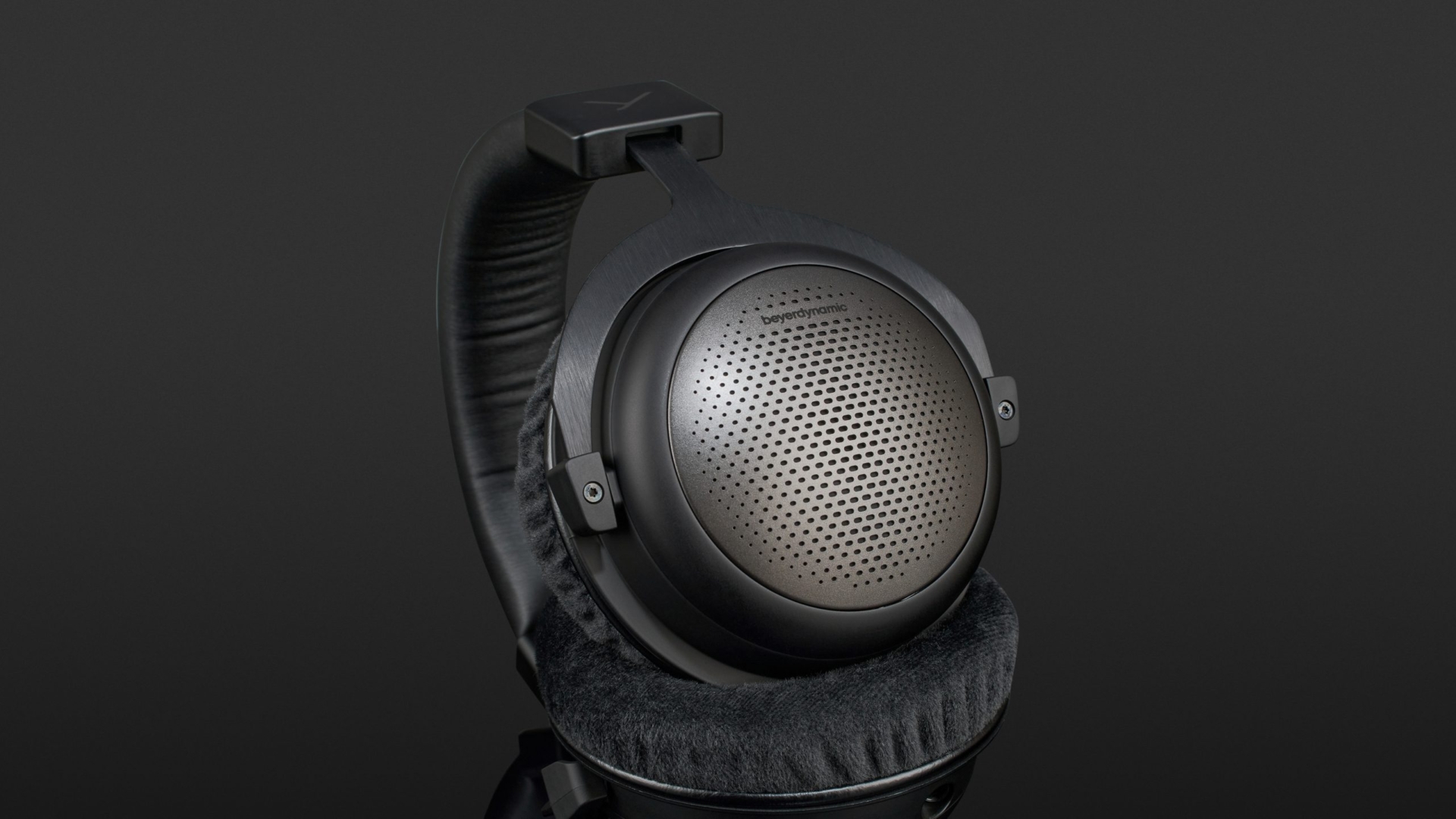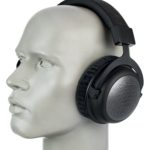To summarise: Visually, technically, and in terms of wearing comfort, the T1 MK3 are great headphones. I would have liked to see another short connection cable like the one that comes with the T5. Unfortunately, I don’t agree with the concept in terms of sound tuning: If really excellent high-frequency reproduction can be delivered by countless cheaper products from the same manufacturer, but this high-end model produces less information (and thus plasticity, liveliness and transient richness) on the stereo stage in the “high-end”, I consider this to be the limit in terms of it being a “question of taste”. I, for one, would welcome Beyerdynamic unleashing the full potential of their Tesla drivers on the audience with future models. Their treble reproduction capabilities are fundamentally fantastic – and they should not hide the fact!
Beyerdynamic present their high-end T1 (open) and T5 (closed) headphones as a MK3 four years after the release of their second generation. Back then, the MK2 not only received full marks from our editorial team for sound but also proudly won “Best Headphones HiFi (March 2016)”. So with a suitable positive bias, we now turn our attention to testing the third generation.

In principle, of course, you don’t have to worry about the T1 MK3s suddenly turning up with a neon yellow headband, permanently soldered connection cables and transducers glued into the housing: High-end customers like consistency and the developers at Beyerdynamic know that. In this price bracket, with well-established products, innovations are (almost) always made in small increments.
Tried and tested principles and components have been retained: The sound conversion continues to be handled by individually measured and paired drivers with proven Tesla technology, and the arrangement of the drivers in the MK3 also follows an “off-axis” principle, so the diaphragm is offset a little at the front and angled slightly toward the ear. This is supposed to provide a roomier sound representation, and in the new version, the connection cable is interchangeable.
Externals
Nevertheless, confusion between MK2 and 3 is virtually impossible because visually, a lot has changed in four years: The recesses (complete with an engraved model number) in the metal headband have disappeared; they are now solid metal mouldings made of brushed aluminium. The rear panel of the drivers – previously a light aluminium tone – is now dark grey and has a fine grid of holes running across it. The velour inlay with discreet “Beyerdynamic” embossing on the top of the headband has been retained.
Handling
Connection to the playback device is made via a three-metre long, textile-sheathed cable with conductors made of OCC-7N copper – copper that is free of oxygen atoms up to the seventh decimal place. If you take a look at the relevant forum discussions about whether 6N or 7N, OFC (Oxygene Free Copper) or – as in this case – OCC (Ohno Continuous Casting) or, in the end, simple solid copper wire in the standard industrial quality is the best transport medium for supplied current, you might get the impression that hi-fi enthusiasts attach great importance to the maximum absence of oxygen in the cable. After my own research, all I can contribute to the topic is that the standard purity grade of “normal” high-purity industrial copper is 6N, which is used to build particle accelerators, ion traps and Mars probes – so it seems to work well even for the most serious tasks. Outside the atomic world, and especially considering the price range of the T1, something that would have struck me as being much more beneficial than the purity of the copper would have been if Beyerdynamic had also included the 1.4-metre short connection cable that comes with the T5 (and vice versa).
Internal values
With its averaged impedance of 33.3 ohms (previously 600), the T1 Gen. 3 can now be used satisfactorily with mobile phones, for example, given their rather weak amplifier output. It transforms a milliwatt of current supplied to it into a characteristic sound pressure level of 100 dB. The frequency response ranges from 5 Hz to 50 kHz, far exceeding human hearing capability, which, of course, qualifies it as reproducing “high-resolution” audio material.
Comfort
The T1’s substantial weight of 378 grams without cable is distributed excellently over the wearer’s head thanks to the thick head and ear padding supported by memory foam – which is particularly helpful for spectacle wearers like me – and it maintains a good balance between pressure and wearing comfort that makes it easy to listen for as long as it takes to get through two (or more) albums. Thanks to their open design, there is constant air circulation, which helps to prevent sweaty ears (something that often happens with closed headphones). Strong transmission of structure-borne sounds, such as with the closed T5, is not an issue here.
Design-related disadvantage: From rush hour traffic to children’s alarms or nagging life partners, disturbing outside noises are not shielded much unless you crank up the T1 so hard that the music eventually masks the ambient noise. Considering the maximum sound pressure level of 124 dB, this is no problem, except, of course, for your own ears. A nice detail: As usual for Beyerdynamic’s top-tier products, the T1 has a serial number engraved in fancy golden letters discreetly hidden on the inside of the headband. A high-quality, microfibre-covered padded hard case for safely storing the T1 when not in use or during transportation is also included.
Sound
The T5 (closed version) MK3 arrived in our editorial office at the same time as the T1. I put it to the test first (to the review) and could not get used to its sound tuning: Although it was Beyerdynamic’s declared aim to improve the upper mids so that voices and instruments would be even more effective, I found that the result (especially with solo instruments in classical and jazz) tended to be nasal and boomy. This was mainly because jazz and classical music – in contrast to modern, smoothly ironed pop music – fortunately often still have relatively large dynamics. This became all the more obvious when the treble necessary to create tonal balance was missing.
Beyerdynamic, with their fabulous Tesla drivers, have no difficulty whatsoever in trimming the frequency response of their headphones towards linearity, as other models such as the DT-1990 Pro (review) impressively demonstrate. Mind you: I have nothing against a “tweaked” frequency response – if it sounds good and is fun, anything goes when it comes to audio.
Unfortunately, our listening test for the T1 MK3 was only slightly more agreeable: When listening to it, it is certainly possible to “understand” what the developers had in mind in terms of sound. Namely, to create a very robust bass foundation, above which a fine, rather discreet low-mid range spreads out, which then – towards the treble – becomes more and more refined, while the treble, on the whole, holds back a good deal so as not to seem exhausting or stressful.
This basic tuning achieves a powerful, compact and warm feel-good sound that works especially well with modern pop productions where the dynamics and frequencies are already “smoothed out” and where nothing sticks out in the mids (my personal blueprint for this sound are the TMA-2s by Aiaiai, which implement this sound ideal extremely well). However, jazz and classical productions (fortunately) often have a largely “natural” dynamic and frequency response so that prominent low-mids in music without accompanying highs quickly seem bumpy and resonant.
The fact that the Tesla drivers installed here are capable of a completely different signature is shown by the equaliser; if you apply a slight treble boost (shelf EQ) of approx. 3 dB, starting at approx. 8 kHz, or – even better – use a tilt EQ to simultaneously boost treble and cut bass, i.e. to “tilt” the frequency curve, the sound of the T1 suddenly begins to sparkle and shine and significantly gains precision and vitality. But you don’t buy a pair of high-end headphones to plug them straight into an equaliser. I don’t know what might have motivated the developers to tune a pair of thousand-euro high-end headphones with less detail in the treble than, for example, a pair half as expensive (DT 1990 Pro) or even a pair that are an eighth as expensive (DT 990 Pro) from the same company. Both these have received top ratings for their good treble reproduction – from the trade press as well as from users (including me). It is a bit like developing a new luxury-class saloon car and then having the marketing department decide to lower the tried and tested high-beam headlights so that the driver doesn’t have to see so much of the stressful traffic.
When asked, Beyerdynamic replied that this was a deliberate, strategic decision; they didn’t want to tire out the buyers of the T-series when it comes to listening with a high-frequency tuning like that of the Pro-series. This is a point of view that I absolutely cannot share. If you pay a high-end price, you have the right to expect the best possible high-frequency reproduction. And this concept has a logical flaw: If you want to protect the listener from exhausting highs, then you don’t need to use an expensive OCC cable with marginally better internal resistance that can, at best, only be proven under laboratory conditions. In this case, the good old copper NF cable that costs one euro per metre will do the job.
The sound impression was also confirmed by our measurements: After a largely linear progression from the sub-bass up to the bass, the frequency response dropped continuously by approx. 20 dB starting at 320 Hz, then culminated in a quiet frequency valley at approx. 2,500 Hz that extended to almost 5 kHz. It was only towards 8 kHz that the T1 was once again affected by a bit of “peak attacker ambition”. Technically, this was not something to be complained about, as there were no frequency holes or resonance peaks, and I will be careful not to criticise the T1 in this respect – Beyerdynamic knows how to build headphones. Nor do I want to rule out the possibility that there will be listeners who will fall in love with the T1 MK3’s overall somewhat subdued yet bass-strong signature. But I also want to be honest with readers who, for an outlay of a thousand euros, want high-end headphones that deliver the highest level of detail across the frequency spectrum – especially in the decisive mids and highs.
Technical specifications
- Ear couplingOver-ear
- Typeopen
- Transducer principledynamic
- Frequency response (headphones)5 - 50.000 Hz
- Impedance33,3 ohms
- Sound pressure level (SPL)100,58 dB
- Pressure averaged from big and small head988,5 g
- Weight with cable466 g
- Weight without cable378 g
- Cable length305 cm
What's in the box
- cable
- 6.35mm stereo jack
- travel case






















































